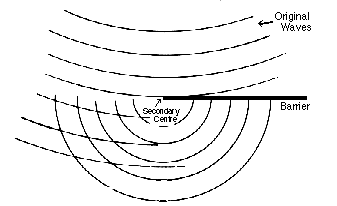The phenomenon in SOUND PROPAGATION whereby a SOUND WAVE moves around an object whose dimensions are smaller than or about equal to the WAVELENGTH of the sound. See SOUND PROPAGATION, section 3b.

High frequency sounds, with short wavelengths, do not diffract around most obstacles, but are absorbed or reflected instead, creating a SOUND SHADOW behind the object. Such is the case with high frequencies with respect to the head, and thus is important in BINAURAL HEARING. Low frequency sounds have wavelengths that are much longer than most objects and barriers, and therefore such waves pass around them undisturbed.
When the wavelength is similar to the dimensions of the object, as with low frequencies and buildings, or mid-range frequencies and the head, the wave diffracts around the object, using its edges as a focal point from which to generate a new wavefront of the same frequency but reduced intensity. Thus, diffraction may aid sound dispersion and DIFFUSION.
Compare: CANCELLATION, INTERFERENCE, PARABOLIC REFLECTOR, REFLECTION, REFRACTION.
As a result of their capability of diffraction, low frequency sounds are difficult to localize or contain in an environment (see CANYON EFFECT, DIFFUSE SOUND FIELD).
An acoustic radiator must be specially designed for good dispersion of high frequencies since this does not occur naturally through diffraction. For instance, the TWEETER of a loudspeaker is shaped in the form of a fan for this purpose. See: ACOUSTIC RADIATION.
home